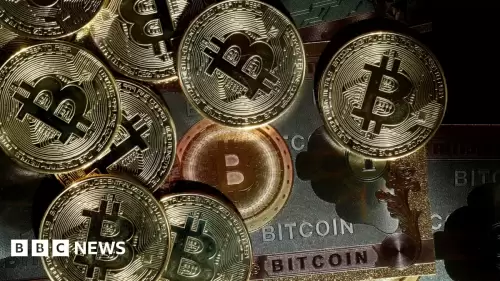 |
|
 |
|
 |
|
 |
|
 |
|
 |
|
 |
|
 |
|
 |
|
 |
|
 |
|
 |
|
 |
|
 |
|
 |
|

The crypto market experienced a moderate decline of 0.37% over the last 24 hours, according to the latest data from CoinDeFi, extending its downward trend.
This correction comes amidst mixed investor sentiment and ongoing macroeconomic uncertainty. Despite this deceleration, the market capitalization remains high, at 2.89 trillion dollars. However, the critical support level of 2.86 trillion dollars could be threatened if selling pressure intensifies. Such a scenario could potentially lead to further market decline towards the 50-day moving average at 2.74 trillion or possibly to the demand zone at 2.3 trillion if BTC falls below $74,000.
On-chain data provides nuanced insights. According to Glassnode, the Net Unrealized Profit/Loss (NUPL) index of Bitcoin stands at 0.52, reflecting cautious holders without widespread panic.
CryptoQuant notes a 15% decrease in flows to exchanges, suggesting limited selling pressure from retail participants. As tweeted by @CryptoAnalystX on May 5: “Market cap testing support at $2.88T. Low exchange flows + ETF strength = potential rebound.”
This cohort of short-term holders (1-3 months) represents the most aggressive players, including professional speculators trading BTC through ETF brokers. In the current bull cycle, their Net Unrealized Profit and Loss (NUPL) has regularly risen to the >40% range, after which… pic.twitter.com/VIFhUaLR79
According to Axel, on-chain signals are still bullish:
“The current NUPL is at 8%, while its 30-day moving average remains negative and holds at -2%. As long as the NUPL does not exceed 40%, the selling pressure from this cohort will remain minimal, which is a bullish signal.”
This signals that, despite the recent price decrease, these short-term holders are not in a state of panic to sell at a loss.
According to the latest data from the U.S. Congress, Republican lawmakers have introduced a new bill that aims to create a comprehensive framework for digital assets. Building on the FIT21 law passed in 2024, this legislation focuses on reducing market concentration while fostering innovation and consumer protection.
The bill, titled the "Digital Asset and Innovation Enhancement Act of 2024," is a response to the rapid development of the digital asset industry and the need for clear and consistent regulation. It seeks to balance promoting technological advancement with safeguarding investors and the financial system.
The bill also proposes to create a new regulatory body for digital assets, which would be responsible for setting standards, licensing, and enforcing rules. This body would be tasked with coordinating with other federal agencies, such as the Securities and Exchange Commission (SEC) and the Commodity Futures Trading Commission (CFTC), to ensure a coherent regulatory landscape.
The introduction of this bill comes as the SEC is increasing its scrutiny of cryptocurrencies. Last week, the SEC filed lawsuits against both Coinbase and Binance, the largest cryptocurrency exchange in the world. The agency has also been working on approving spot Bitcoin ETFs, which could provide another avenue for institutional investment in crypto.
The new bill is likely to be met with mixed reactions. Some experts believe that it does not go far enough in protecting consumers and could stifle innovation. Others argue that it is a necessary step towards integrating digital assets into the mainstream financial system.
The bill will now be referred to the relevant House committee for further consideration. If approved by both chambers of Congress and signed by the president, it will become law.
The SEC has unveiled the agenda for its upcoming roundtable, set for Thursday at 9:00 AM ET. Notably, the event will be divided into two parts, likely addressing real-world assets (RWA) and broader financial instruments.
“The SEC’s focus on RWAs is significant. Tokenized assets could unlock trillions, which is bullish for the next crypto wave,” writes CryptoLawyer.
This division in the agenda suggests that the SEC is planning to take a broader approach to regulating crypto, considering not only Bitcoin and ether but also other types of digital assets, such as those used in DeFi and Web3.
The SEC’s interest in RWA is also noteworthy, as it could lead to the approval of more crypto products, such as exchange-traded funds (ETFs), which could open up the market to even more investors.
The SEC’s actions will be closely watched by the crypto community, as they could have a major impact on the future of the industry.
Bitcoin price followed the broader downward trend, decreasing slightly by 0.23%. However, despite this decline, Bitcoin spot exchange-traded funds (ETFs) in the U.S. saw new net inflows, indicating persistent institutional interest, even amidst temporary price declines.
The largest net influx came from BlackRock’s iShares Bitcoin
免责声明:info@kdj.com
所提供的信息并非交易建议。根据本文提供的信息进行的任何投资,kdj.com不承担任何责任。加密货币具有高波动性,强烈建议您深入研究后,谨慎投资!
如您认为本网站上使用的内容侵犯了您的版权,请立即联系我们(info@kdj.com),我们将及时删除。
-

- 加密波动和令牌解锁:导航风暴
- 2025-08-05 15:57:47
- 令牌解锁可以激发加密货币市场的波动。了解这些事件的影响,策略和社区情绪。
-

-

- 比特币,美联储税率和加密货币:纽约人的拍摄
- 2025-08-05 13:23:49
- 导航加密货币嗡嗡声:比特币的弹性,税率降低了耳语以及加密货币的兴起。在这个财务前沿获取内部勺子。
-

- 警察,加密货币,比特币意外收获:意外收益和警告性故事
- 2025-08-05 13:18:22
- 从受益于比特币意外收获的警察部队到有关加密货币骗局的警告,我们深入研究了执法和数字资产的交汇处。
-

-

- Bitmine的以太坊财政部:加密统治的纽约分钟
- 2025-08-05 13:01:22
- Bitmine的快速积累以太坊激发了加密纪念品的一场比赛,将其持股推向了30亿美元,并巩固了其作为主要参与者的地位。
-

- 以太坊的开放兴趣繁荣:机构资本如何改变游戏
- 2025-08-05 12:37:21
- 以太坊的开放兴趣达到记录最高,因为机构投资者涌向ETH,这是由DEFI和智能合同创新所吸引的。但这是可持续的吗?
-

-






























































